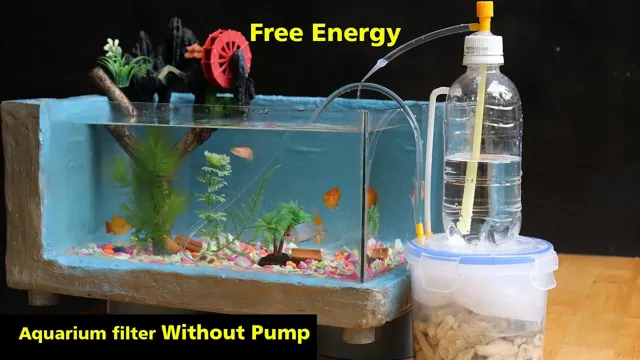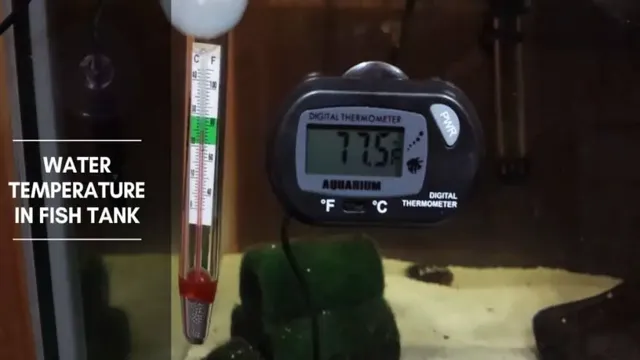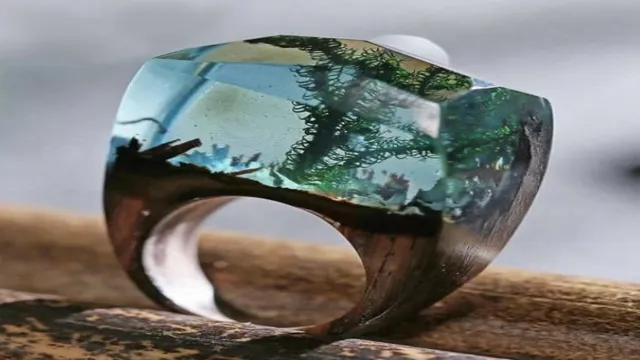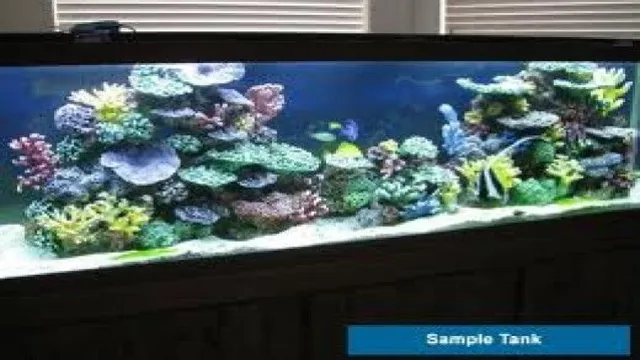If you love aquatic life, then setting up an aquarium at your home or workplace can be a gratifying experience. However, it takes effort and dedication to keep your aquarium thriving. One of the essential components of an aquarium is its filtration system.
It helps maintain water quality and ensures that your fish stay healthy and happy. Aquarium filters usually come with an integrated pump that circulates water through the filter media and back into the tank. But, what if you want to create a filter without a pump? In this blog post, we’ll teach you how to make an aquarium filter without a pump and keep your fish healthy.
Why Choose a Pumpless Filtration System?
If you’re looking for a more natural and low-maintenance way to filter your aquarium, then a pumpless filtration system may be just what you need. These systems rely on natural processes and gravity to filter the water, rather than using a mechanical pump. One of the main benefits of this approach is that it can save you money on energy costs while also reducing noise and vibration in your tank.
Additionally, pumpless filters are often easier to clean and maintain, since there are no moving parts to worry about. To create a pumpless filter, you can use materials like sponge, gravel, and plant matter to create a natural barrier that traps debris and encourages the growth of beneficial bacteria. With a little creativity and experimentation, you can create a filter that works for your tank and helps keep your aquatic friends healthy and happy.
Cost-effective and Energy-efficient
If you’re looking for a filtration system that is both cost-effective and energy-efficient, then a pumpless filtration system may be the perfect choice for you. Unlike traditional systems which require a pump to circulate water through the filters, a pumpless system relies on gravity to do the job. This means you’ll be able to save money on electricity while also reducing your carbon footprint.
Not having a pump also means that maintenance is much simpler and easier since there are fewer parts that can break or wear down over time. You’ll be able to save money on replacement parts while also reducing the time and effort required to keep your system working properly. In addition to being cost-effective and energy-efficient, pumpless filtration systems are also highly effective at removing contaminants from your water.
The filters are designed to capture a wide range of particles and impurities, ensuring that your water is clean and safe to drink. Since the water flows through the filters more slowly than it would with a pump, the filtration process is more thorough and effective. This means you’ll be able to enjoy better-tasting water that is free from any unwanted odors or flavors.
Overall, a pumpless filtration system is the perfect choice for anyone who wants to save money on their water filtration system while also reducing their energy consumption. With fewer moving parts and a simpler design, maintenance is easy and hassle-free. So if you’re looking for a filtration system that is both effective and efficient, be sure to consider a pumpless system for your home or business.

Less Noise and Vibration
If you’re tired of the noise and vibration that comes with traditional filtration systems, a pumpless filtration system might be the perfect solution for you. These innovative systems use gravity and natural water flow instead of a pump to move water through the filter, resulting in a much quieter and vibration-free operation. Not only does this make for a more peaceful and enjoyable swimming experience, but it also means less wear and tear on your pool equipment.
With a pumpless filtration system, you’ll be able to relax by the pool without the distracting hum of a pump in the background. So why choose a pump-based system when you can enjoy all the benefits of clean, clear water with less noise and maintenance with a pumpless filtration system?
Low Maintenance
If you’re tired of constantly maintaining a traditional filtration system, then a pumpless filtration system may be the perfect solution for you. By removing the need for a pump, these filters are incredibly low maintenance and require less effort and attention. This not only saves you time and money but also improves the cleanliness of your aquarium or pond.
Plus, without a pump, there are fewer parts to break down, leading to longer-lasting and more cost-effective filtration systems. If you’re someone who values convenience and wants a reliable filter that requires minimal upkeep, then a pumpless filtration system is definitely worth considering. Opting for such a system provides you with a hassle-free way to keep your aquatic pets healthy, happy, and thriving.
How to Make an Aquarium Filter without a Pump
Aquarium filters play an important role in maintaining your fish’s health and the overall cleanliness of your tank. But what if you don’t have a pump to power your filter? Not to worry, because you can still create an effective filter without a pump using a few simple materials. To make an aquarium filter without a pump, you can use a sponge, activated charcoal, and filter floss.
Begin by cutting a sponge to fit the size of your filter compartment and place it at the bottom. Layer activated charcoal on top of the sponge, and then place the filter floss on top of the charcoal. The sponge serves as the mechanical filter, while the activated charcoal removes toxins and impurities from the water.
The filter floss then acts as the final barrier to catch any remaining debris. Using this method, you can create a filter that keeps your tank clean and happy, even without a pump! (See Also: How to Keep Snails in Aquarium: Tips and Tricks for a Healthy and Happy Tank Environment)
Step 1: Gather the Materials
If you’re looking to make an aquarium filter without a pump, the first step is to gather the necessary materials. You will need a container, such as a plastic bottle or jar, some filter media, aquarium tubing, and an airline tube. The container will serve as the main housing for your filter, while the filter media will help to trap debris and other impurities.
Aquarium tubing will serve as the conduit for water to flow through the filter, while the airline tube will help to maintain the water flow. Once you have all of your materials together, you can begin assembling your filter. By making your own aquarium filter, you can ensure that your fish and other aquatic creatures have clean and healthy water to thrive in.
So, gather your materials and let’s get started!
Step 2: Create the Filter Media Chamber and Inlet/Outlet Holes
aquarium filter, media chamber, inlet/outlet holes, DIY, pump-less Now that you’ve gathered all the necessary materials for making an aquarium filter without a pump, it’s time to move on to step two: creating the filter media chamber and inlet/outlet holes. First, take the plastic bottle and drill a hole near the bottom, but not too close, as you want the water to pass through the filter media at a steady pace. Then, cut the bottle in half and place the top half into the bottom half.
This will create the filter media chamber. Next, cut two more holes on either side of the bottle near the top. These will serve as the inlet and outlet holes for the water.
By placing the inlet hole above the outlet hole, you create a siphoning effect that will pull the water through the filter media chamber. Once you have completed this step, you’re ready to move on to the next step in creating your DIY, pump-less aquarium filter.
Step 3: Add Filter Media
Now, it’s time to add the filter media to your homemade aquarium filter. Filter media is essential for removing debris, waste, and harmful chemicals from the water. There are several types of filter media to choose from, including mechanical, biological, and chemical.
Mechanical filter media captures large particles, such as uneaten food or plant debris, while biological filter media provides a home for beneficial bacteria to grow and break down waste. Chemical filter media, such as activated carbon, removes impurities and toxins. Depending on the size and type of your filter, you may need to layer different types of media.
Be sure to follow the manufacturer’s instructions for your particular filter. Once you’ve added the media, place the lid or top of the filter over the container, and your aquarium filter is ready to use! By creating your own filter, you not only save money but have an environmentally friendly option that can last for years. So, take the initiative and make use of this easy, budget-friendly filter to keep your aquarium water clean and healthy for your aquatic pets.
Step 4: Install Intake/Outlet Tubing
When it comes to making an aquarium filter without a pump, one important step is to install intake and outlet tubing. Not only do these tubes help keep the water flowing properly, but they also provide a way for your filter media to do its job of cleaning the water. When selecting tubing, make sure it is the right size for your filter and aquarium.
Next, install the intake tubing by placing it in the water and attaching it to the intake of your filter. For the outlet tubing, attach it to the outlet of your filter and secure it to a spot above the water line. This will prevent any water from leaking out of the tubing and ensure proper circulation of clean water in your aquarium.
Remember, the tubing is not just a necessary component of your filter, but it also contributes to the overall health and wellbeing of your aquatic inhabitants. So, take this step seriously and enjoy watching a thriving aquarium ecosystem.
Step 5: Place the Filter in the Aquarium
One of the most important steps in making an aquarium filter without a pump is to place the filter in the aquarium correctly. This step is essential to ensure that the filter functions effectively in removing debris and waste from the water. To begin, find a suitable location for the filter within the tank.
It’s best to place the filter near the inflow of the water, which can be achieved by attaching a hose to the filter output and placing it near the top of the tank. Make sure the filter is stable and secure, and adjust the position as needed. Once the filter is in place, add the filter media, which can include materials such as foam, filter floss, or bio media. (See Also: How to Fix Ammonia in Aquarium: Tips and Tricks for a Healthy Tank)
Finally, turn on the water source and let the filter run for a few minutes to test its efficacy. Remember, the location and stability of the filter are crucial to ensuring it functions correctly. With these steps in mind, you can successfully make an aquarium filter without a pump and keep your aquarium clean and healthy.
Step 6: Monitor and Clean the Filter
Maintaining a clean filter is crucial for the well-being of your aquarium pets. Without a pump, natural filtration is key to keeping the water clean, so it’s important to monitor and clean the filter regularly. A dirty filter can cause harmful bacteria and particles to build up in the water, which can lead to sickness and death for your fish.
To clean the filter, first, turn off the aquarium light and unplug the filter. Next, remove the filter media and rinse it with clean water to remove any debris and build-up. If needed, replace the filter media entirely.
Then, use a clean cloth or sponge to wipe down the inside of the filter and any visible parts. Reassemble the filter and plug it back in. It’s recommended to clean the filter every two to three weeks in order to maintain a healthy aquatic environment for your pets.
By keeping the filter clean, you’ll not only improve the quality of the water but also the overall health of your fish.
Alternative Pumpless Filter Options
If you’re wondering how to make an aquarium filter without a pump, there are several alternative options to consider. One option is the sponge filter, which uses an air pump to pull water through a sponge that traps waste and debris. Another option is the hang-on-back filter, which hangs on the back of the tank and uses gravity to pull water through a filter media.
You could also try a canister filter, which is a bit more complex but can be highly effective and customizable. With a canister filter, water is pulled into a canister, where it passes through various types of filter media before dispelling back into the tank. Regardless of which option you choose, it’s important to research and follow proper maintenance procedures to ensure the filter is working effectively and keeping your aquarium safe and healthy.
Sponge Filter
If you’re looking for an alternative pumpless filter option for your aquarium, a sponge filter might be worth considering. Not only is it simple and easy to install, but it’s also affordable and low maintenance. The way it works is that as water is pulled through the sponge, beneficial bacteria grows and helps to break down waste.
The sponge also provides a place for mechanical filtration, collecting debris and preventing it from circulating in the water. Plus, it’s gentle enough for delicate fish and shrimp, making it a popular choice among hobbyists. If you’re interested in trying out a sponge filter, make sure to choose one that’s the appropriate size for your tank and consider cleaning it every few weeks to keep it functioning properly.
With its effectiveness and ease of use, a sponge filter might just be the perfect option for your aquarium filtration needs.
Undergravel Filter
Undergravel filter When it comes to aquarium filtration, there are many options available. While pumps and powerheads are the standard, there are also alternative pumpless options to consider. Undergravel filters are one such option.
They work by filtering water through the gravel at the bottom of the tank, using the natural biological processes of the beneficial bacteria in the gravel. This process creates a cleaner, healthier water quality for fish and plants to thrive in. Undergravel filters are simple to maintain, but they do require regular cleaning to prevent excess debris buildup.
Additionally, they may not be suitable for all tank setups, such as those with heavy decorations or plants that can interfere with the filter’s function. However, with proper care and consideration, an undergravel filter can be a viable pumpless option for aquarium filtration. (See Also: How to Clean Aquarium Fungus: A Step-by-Step Guide to Eliminate Fungal Growth)
Hang-on-Back Filter with an Air Pump
If you’re looking for an alternative to a pumpless filter, a Hang-on-Back filter with an air pump can be a great option. This type of filter uses a powerhead to draw water up from the tank and push it through a filter cartridge. The air pump creates a flow of water through the filter, forcing out debris and waste particles.
Hang-on-Back filters are easy to install and take up little space in your tank. They’re also easy to maintain, as the filter cartridge can be replaced when necessary. So if you’re looking for a reliable and effective way to keep your aquarium clean, consider trying out a Hang-on-Back filter with an air pump.
Conclusion
In conclusion, creating an aquarium filter without a traditional pump may be easier than you think. By harnessing the power of nature, such as using live plants, natural filtering agents, and even a simple gravity-based system, you can effectively maintain the health and happiness of your aquatic pets. In doing so, you not only save money on expensive equipment but also contribute to a more sustainable and environmentally-friendly aquarium.
So dive in and get creative with your filtration methods – your fish will thank you!”
FAQs
What materials do I need to make an aquarium filter without a pump?
To make an aquarium filter without a pump, you will need a plastic bottle, filter floss, activated carbon, and optional ceramic filter media.
Can I use a plastic soda bottle to make an aquarium filter without a pump?
Yes, a plastic soda bottle works perfectly fine as a base for making an aquarium filter without a pump.
How do I assemble the filter for my aquarium without a pump?
Cut the plastic bottle in half and fill the bottom half with filter floss. Then, add a layer of activated carbon on top of the filter floss, followed by a layer of ceramic filter media (optional). Lastly, place the top half of the bottle back on and pierce several small holes at the bottom.
How often should I clean my aquarium filter without a pump?
It is recommended to clean your aquarium filter without a pump once every two weeks or as needed.
What are the benefits of using a filter in my aquarium?
A filter helps to remove excess waste and debris from your aquarium, creating a healthier environment for your fish to live in.
How long does the filter media last in my aquarium filter without a pump?
The filter media typically lasts between 2-4 weeks, depending on the size of your aquarium and the stocking level of your fish.
Can I use a water bottle as a filter without a pump for a larger aquarium?
It is not recommended to use a water bottle as a filter for a larger aquarium as it may not be able to handle the volume of water and the waste produced by the fish.







